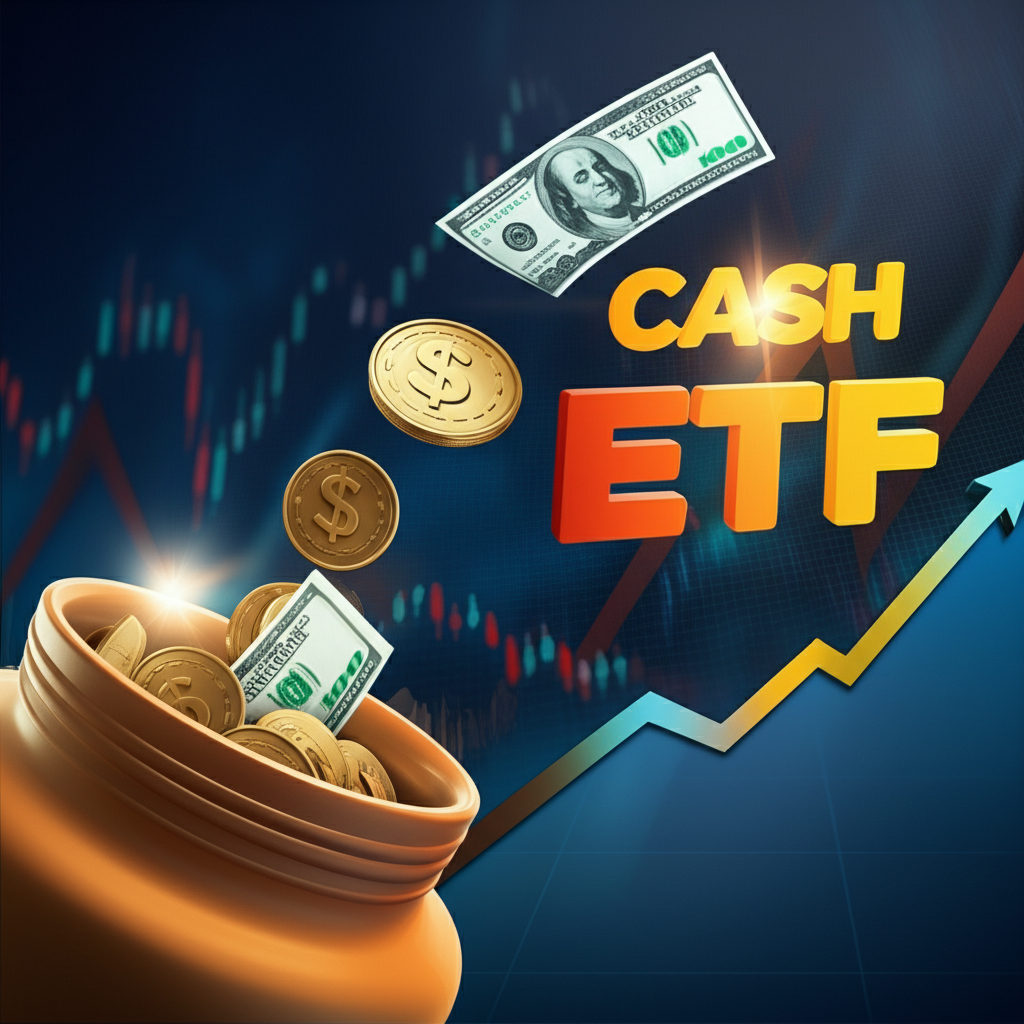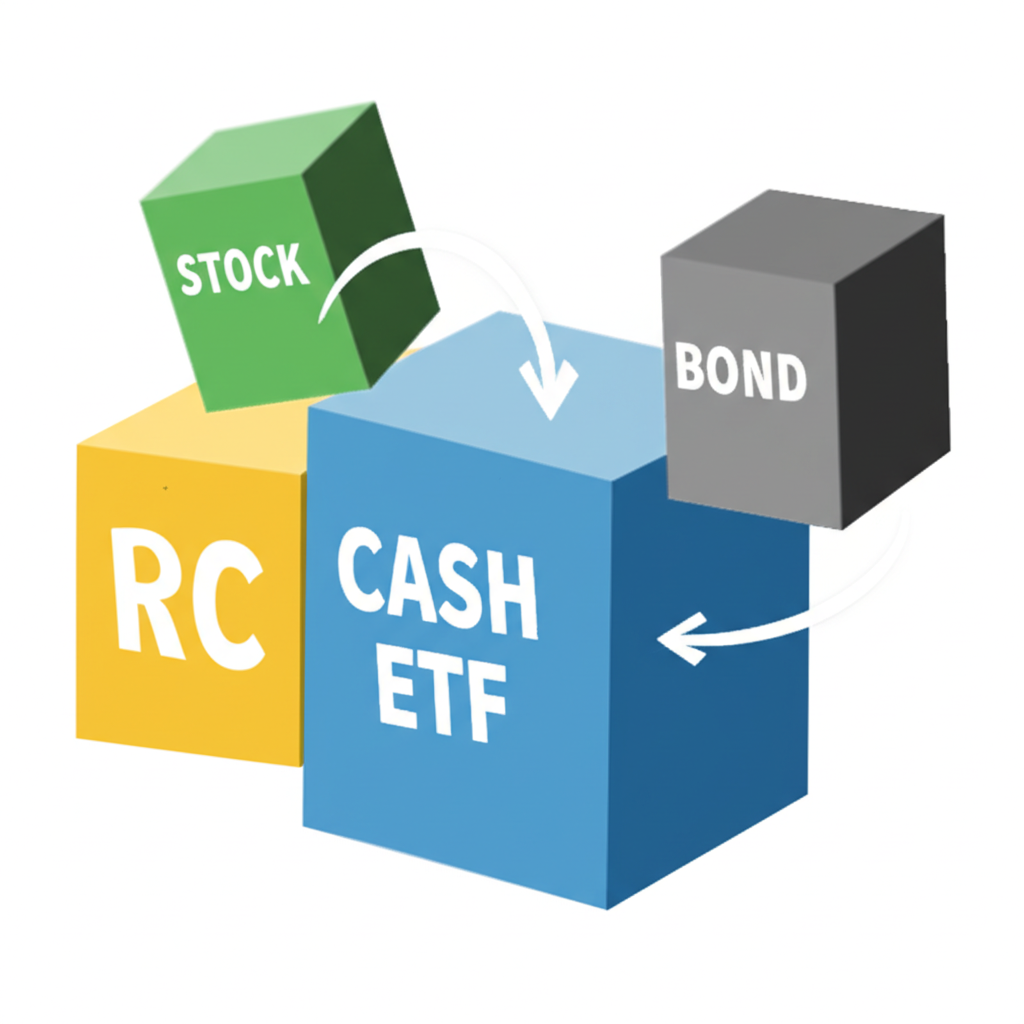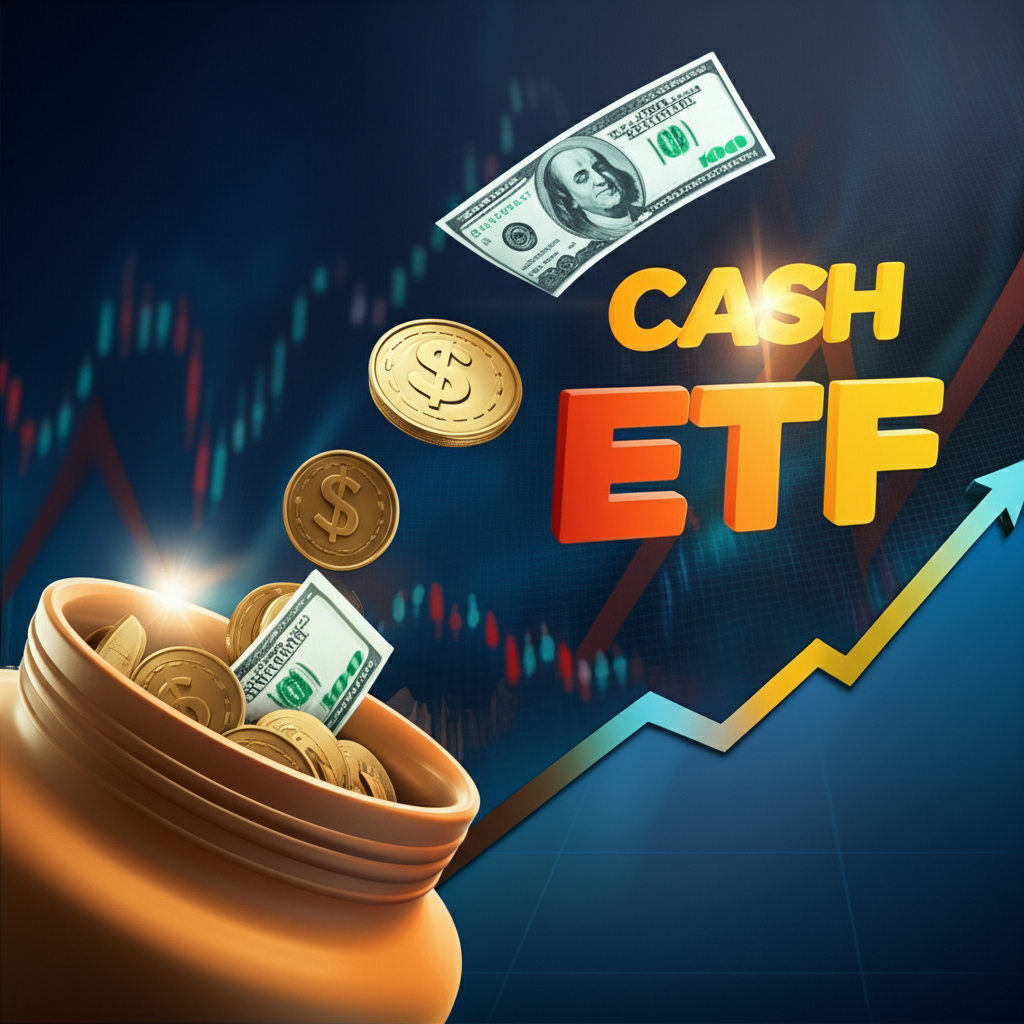Introduction to Cash ETFs: Your Gateway to Higher Yields and Liquidity

In an era where inflation quietly erodes the value of idle cash, finding a reliable place to park your short-term funds has never been more critical. Traditional savings accounts, once considered a safe haven, now offer interest rates that often fail to keep up with rising prices. As a result, investors are increasingly turning to smarter alternatives—chief among them, the **cash ETF**. Also known as money market ETFs or ultra-short bond ETFs, these investment vehicles combine stability, liquidity, and the potential for stronger returns. Designed to preserve capital while generating income, cash ETFs invest in high-quality, short-term debt instruments such as U.S. Treasury bills, commercial paper, and repurchase agreements. By doing so, they offer a compelling upgrade over conventional bank accounts—providing access to higher yields without compromising on safety or flexibility. For those seeking to optimize their cash holdings, understanding how the **best cash ETF** can enhance returns is the first step toward more effective financial management.
Why Invest in Cash ETFs? Key Benefits for Smart Money Management

Cash ETFs have emerged as a strategic tool for modern investors looking to strike a balance between earning meaningful returns and maintaining immediate access to funds. Unlike long-term investments that expose capital to market swings, or stagnant savings accounts that offer minimal growth, cash ETFs occupy a unique middle ground—ideal for managing temporary cash surpluses, emergency reserves, or funds awaiting reinvestment.
Superior Yields Compared to Traditional Savings
One of the most compelling reasons to consider a cash ETF is its ability to deliver higher yields than standard bank savings options. While the average national savings account yielded around 0.47% in early 2024, many top-tier cash ETFs were generating returns well above 4%, closely tracking the Federal Reserve’s benchmark interest rates. This performance gap isn’t accidental. Cash ETFs are structured to respond quickly to shifts in interest rates by continuously rolling over their short-duration holdings—meaning they can capture rising yields faster than traditional savings vehicles, which often lag behind rate hikes. The underlying portfolio typically includes top-tier debt securities like government-issued T-bills and investment-grade corporate paper, managed to maximize return within a tight risk framework. For individuals with sizable cash positions—whether from a bonus, home sale, or portfolio rebalancing—this yield differential can translate into thousands of dollars in additional income annually.
High Liquidity and Accessibility
Liquidity is another area where cash ETFs shine. Unlike mutual funds or traditional money market funds, which settle at the end of the trading day, cash ETFs trade on major stock exchanges like any other stock. This means investors can buy or sell shares throughout market hours at real-time prices. Need access to funds quickly? A simple trade executes within seconds, with proceeds typically available in your brokerage account within one to two business days. This level of responsiveness makes cash ETFs a practical solution for emergency funds, short-term savings goals, or as a temporary holding account during periods of market uncertainty. There’s no need to wait for redemption requests to process or deal with minimum withdrawal windows—just seamless access when you need it most.
Diversification and Portfolio Rebalancing Tool
Beyond serving as a high-yield parking spot for cash, a **cash ETF** plays a strategic role in portfolio construction. For adherents of disciplined investing philosophies like the Bogleheads approach, maintaining a proper asset allocation includes holding a portion of assets in low-risk, liquid instruments. Cash ETFs fulfill this role efficiently, offering both income generation and stability. During volatile markets, shifting a segment of equities into a cash ETF can reduce exposure without fully exiting the investment ecosystem. Additionally, when selling assets to rebalance or preparing to enter new positions, investors can deploy proceeds into a cash ETF rather than letting money sit idle in a low-interest sweep account. This not only reduces “cash drag” but also keeps capital active and productive.
Understanding the Risks: What to Watch Out For with Cash ETFs

While cash ETFs are widely regarded as low-risk investments, they are not risk-free. Recognizing the potential downsides allows investors to make informed decisions and align these instruments with their overall financial strategy.
Interest Rate Risk and Yield Fluctuations
Although cash ETFs primarily hold short-term securities—limiting their sensitivity to interest rate changes—they are still affected by monetary policy shifts. When the Federal Reserve raises rates, newly issued debt carries higher coupons, which can cause existing lower-yielding holdings to lose slight value. However, because these funds regularly mature and reinvest, they quickly adapt to new rate environments. The net effect is that rising rates usually benefit investors over time by boosting the fund’s yield. Conversely, falling rates can lead to declining returns. It’s important to understand that the yield on a cash ETF is variable, not fixed, and will ebb and flow with broader economic conditions.
Inflation Risk: The Silent Wealth Eroder
Even when a cash ETF outperforms a savings account, it may still fall short of outpacing inflation. If inflation runs at 3% and your ETF yields 4%, your real return is only 1%. In periods of high inflation, nominal gains can mask a gradual decline in purchasing power. This makes cash ETFs unsuitable as long-term wealth-building tools. They are best viewed as capital preservation vehicles for short- to medium-term horizons. For long-term growth, equities and other appreciating assets remain essential components of a balanced portfolio.
Credit Risk and Underlying Holdings
The safety of a cash ETF depends largely on what it owns. Funds that focus exclusively on U.S. Treasury securities—such as T-bills and agency debt—carry virtually no credit risk, as they are backed by the full faith and credit of the U.S. government. Others, known as “prime” money market ETFs, include commercial paper and short-term corporate bonds, which offer slightly higher yields but introduce exposure to issuer default. While defaults are rare among investment-grade borrowers, they are not impossible—especially during economic downturns. Always review the fund’s holdings and average credit rating before investing. For maximum safety, prioritize government-only portfolios.
Expense Ratios: The Cost of Convenience
Every cash ETF charges an annual expense ratio, which directly reduces investor returns. While these fees are typically low—often between 0.05% and 0.35%—they can add up over time, particularly when yields are modest. For example, an ETF yielding 4.6% with a 0.20% expense ratio delivers a net return of 4.4%. Choosing a fund with a lower fee structure means keeping more of the income generated. Given the narrow margin between competing products, even small differences in cost can have a meaningful impact on long-term performance, especially for large balances.
How to Choose the Best Cash ETF: A Selection Guide
Selecting the right **cash ETF** isn’t just about chasing the highest yield—it’s about aligning the fund’s characteristics with your financial goals, risk tolerance, and tax situation.
Analyzing Yield and Expense Ratios
Start by comparing the 7-day SEC yield, which standardizes income reporting across funds and allows for apples-to-apples comparisons. While past yields don’t guarantee future performance, they offer insight into how a fund has responded to current interest rate levels. Simultaneously, examine the expense ratio. Funds from major providers like Vanguard, Schwab, and iShares often feature ultra-low costs, sometimes as low as 0.03%–0.10%. A good rule of thumb is to favor ETFs with expense ratios under 0.15%, ensuring that the majority of income flows directly to you.
Examining Underlying Holdings and Credit Quality
Dig into the fund’s portfolio composition. Does it hold only U.S. Treasuries, or does it include corporate debt? Treasury-only funds like BIL or SHV offer the strongest credit profile and are exempt from state and local taxes, making them ideal for residents in high-tax states. Prime or corporate-focused funds may offer marginally higher yields but come with added credit risk. Understanding this trade-off helps you decide whether to prioritize safety or incremental return.
Issuer Reputation and Fund Size
Stick with established asset managers like Vanguard, BlackRock (iShares), JPMorgan, PIMCO, and Schwab. These firms have decades of experience managing fixed-income portfolios and robust operational infrastructure. Larger fund sizes also signal market confidence and contribute to tighter bid-ask spreads and smoother trading. While smaller niche funds may exist, opting for a well-known provider adds a layer of reliability and transparency.
Liquidity and Trading Volume
High average daily trading volume ensures you can enter or exit positions with minimal price impact. Widely held ETFs like JPST, MINT, and BIL routinely see millions in daily volume, making them highly liquid. Low-volume funds may suffer from wider spreads, increasing transaction costs. For most investors, liquidity won’t be a concern with mainstream cash ETFs—but it’s still worth verifying before investing.
Top Cash ETFs to Consider for US Investors (2024 Recommendations)
The landscape of cash ETFs features several standout options that combine strong yields, low fees, and excellent liquidity. Below are some of the most frequently recommended choices for U.S. investors:
* **JPMorgan Ultra-Short Income ETF (JPST):** Actively managed, JPST targets current income through a diversified mix of investment-grade floating- and fixed-rate securities. With an average duration of less than one year and an expense ratio around 0.18%, it strikes a balance between yield and stability, appealing to those who want slightly more income without taking on excessive risk.
* **PIMCO Enhanced Short Maturity Active ETF (MINT):** Another actively managed option, MINT invests across a broad range of short-term, high-quality fixed-income instruments, including government, corporate, and securitized debt. Known for consistent performance, it has an expense ratio of approximately 0.36%—slightly higher, but justified by its active management approach.
* **SPDR Bloomberg 1-3 Month T-Bill ETF (BIL):** Ideal for conservative investors, BIL holds only U.S. Treasury bills with maturities of one to three months. This makes it one of the safest cash alternatives available, with virtually no credit risk and income exempt from state and local taxes. Its expense ratio is competitive, typically around 0.13%.
* **iShares Short Treasury Bond ETF (SHV):** Focused on short-term U.S. Treasury securities with maturities of one to twelve months, SHV offers slightly longer duration than BIL, potentially translating to marginally higher yields. It also benefits from tax-exempt income and a low expense ratio of about 0.15%.
* **Vanguard Ultra-Short Bond ETF (VUSB):** Offering broad diversification across short-term investment-grade debt—including corporate, government, and securitized bonds—VUSB aims to deliver higher income than money market funds. With an ultra-low expense ratio of roughly 0.10%, it appeals to cost-conscious investors seeking modest yield enhancement.
*Disclaimer: This list is for informational purposes only and should not be considered financial advice. Investment decisions should be made based on your individual financial situation, risk tolerance, and consultation with a qualified financial advisor. Yields and expense ratios are subject to change.*
Cash ETFs vs. Alternatives: Which is Best for Your Needs?
Knowing how cash ETFs compare to other cash management tools helps you make a choice that fits your priorities—whether it’s safety, yield, accessibility, or tax efficiency.
Money Market Funds (MMFs)
Money market funds have long been the standard for cash management. Like cash ETFs, they invest in short-term, high-quality debt. However, key differences exist. Most retail MMFs maintain a stable $1.00 net asset value (NAV), giving investors psychological comfort. They are typically purchased and redeemed at the end of the trading day, with no intraday trading. Cash ETFs, in contrast, trade on exchanges like stocks, allowing for real-time pricing and immediate execution. While their NAV can fluctuate slightly—rarely deviating more than 0.01%—this minimal volatility is offset by greater trading flexibility and often lower fees. For those who prefer simplicity and stability, MMFs remain a solid choice; for those who value control and liquidity, ETFs often win out.
High-Yield Savings Accounts (HYSAs)
High-Yield Savings Accounts have gained popularity thanks to their ease of use and FDIC insurance, which protects up to $250,000 per depositor, per bank. This makes HYSAs an excellent option for core emergency funds, especially for risk-averse investors. They offer instant access via transfers or debit cards and require no brokerage account. However, while HYSA rates have improved, they may still trail the yields of top cash ETFs, particularly during rising rate cycles. Additionally, HYSA rates are set at the bank’s discretion and may not adjust as quickly as ETF yields. For smaller balances or those requiring absolute safety, HYSAs are hard to beat. For larger cash reserves, a cash ETF may offer better after-fee returns.
Short-Term Treasury Bills and Bond ETFs
Buying individual Treasury bills directly through TreasuryDirect or a brokerage provides full control and the highest level of safety, backed by the U.S. government. T-bills are sold at a discount and pay face value at maturity, with interest exempt from state and local taxes. However, managing a ladder of individual bills requires ongoing attention—timing maturities, reinvesting proceeds, and monitoring auctions. Short-term Treasury ETFs like BIL or SHV automate this process, offering instant diversification and professional management without the administrative burden. Notably, Warren Buffett has long favored U.S. Treasury bills for managing Berkshire Hathaway’s massive cash reserves. According to public filings, Buffett consistently allocates billions to U.S. Treasury bills for short-term cash management, underscoring their role in preserving capital while maintaining liquidity and safety at scale.
Tax Implications of Investing in Cash ETFs
Taxes play a crucial role in determining your net return from any investment, and cash ETFs are no exception. Interest income from these funds is generally taxed as ordinary income at your marginal tax rate—just like bank interest or bond coupons. However, there’s an important distinction: if the fund invests primarily in U.S. Treasury securities, the income derived from those holdings is exempt from state and local income taxes. This can be a significant advantage for investors in high-tax states like California, New York, or New Jersey. For example, a 4.5% yield from a Treasury-focused ETF like BIL may effectively be worth more than a 4.6% yield from a corporate-focused fund if you’re paying 5% in state taxes. Always check the fund’s tax breakdown—available in its annual reports or prospectus—or consult a tax professional to understand how distributions will be treated.
Capital gains may also apply if you sell shares above your purchase price. Short-term gains (held less than a year) are taxed as ordinary income, while long-term gains (held over a year) qualify for lower rates. Given that most investors use cash ETFs for short-term holding, these gains are typically short-term. However, the price stability of these funds means large capital gains are uncommon.
When to Use (and When NOT to Use) a Cash ETF
Cash ETFs are versatile, but they’re not a one-size-fits-all solution. Knowing when to deploy them—and when to choose something else—can enhance both safety and performance.
Ideal Scenarios: Emergency Funds, Short-Term Savings, Portfolio Rebalancing
* **Emergency Funds:** While FDIC-insured HYSAs are ideal for the base layer of an emergency fund, a portion can be allocated to a cash ETF—especially for larger reserves exceeding $250,000. The higher yield helps offset inflation, and the liquidity ensures quick access when needed.
* **Short-Term Savings Goals:** Whether saving for a home down payment, car purchase, or vacation within 1–3 years, a cash ETF offers better growth potential than a savings account, with minimal risk.
* **Portfolio Rebalancing and Staging Ground:** After selling stocks or bonds, parking proceeds in a cash ETF allows you to earn income while waiting for the right entry point. This prevents idle cash from losing value over time.
* **Market Volatility Hedge:** During uncertain times, shifting part of your portfolio into a cash ETF can reduce risk without fully exiting the market. It serves as a safe harbor, ready to be redeployed when opportunities arise.
Suboptimal Scenarios: Long-Term Growth, Day Trading, High-Risk Speculation
* **Long-Term Growth:** Cash ETFs are not designed to grow wealth over decades. Their returns are unlikely to outpace inflation significantly, making them inadequate for retirement or long-term accumulation goals.
* **Day Trading or High-Risk Speculation:** These funds are intentionally stable. Their minimal price movement makes them unsuitable for traders seeking volatility or quick profits.
* **Investors Uncomfortable with Any Price Fluctuation:** Although rare, cash ETFs can experience slight NAV dips. If you require absolute certainty in value—such as for legal or accounting purposes—an FDIC-insured HYSA or stable NAV money market fund may be more appropriate. A 2023 report from the Federal Reserve highlighted the stability of money market funds and ultra-short duration ETFs but also acknowledged the potential for minor NAV changes under extreme market stress.
Conclusion: Making Informed Decisions for Your Cash Reserves
The decision to use a **cash ETF** should be rooted in clarity about your financial objectives. These funds offer a modern, efficient way to earn higher yields on idle cash while preserving liquidity and minimizing risk. Whether you’re building an emergency cushion, saving for a near-term goal, or managing a complex portfolio, a well-chosen cash ETF can play a strategic role. Success lies in evaluating yield, fees, credit quality, and tax treatment—not just in isolation, but as part of a cohesive financial plan. By comparing options like high-yield savings accounts, money market funds, and direct Treasury purchases, you can determine where a **cash ETF** fits best in your strategy. With thoughtful selection and disciplined use, this simple tool can help ensure your cash is not just safe—but also working as hard as the rest of your portfolio.
Frequently Asked Questions (FAQ)
What is the primary objective of investing in a cash ETF?
The primary objective of investing in a cash ETF is to generate a competitive yield on cash reserves while maintaining high liquidity and capital preservation. It aims to offer better returns than traditional savings accounts without the higher risks associated with longer-term investments.
How do the yields of cash ETFs typically compare to traditional bank savings accounts?
Cash ETFs generally offer superior yields compared to traditional bank savings accounts. This is because they invest in a diversified portfolio of short-term debt instruments that are actively managed to reflect current market interest rates more efficiently.
Are there any specific risks associated with cash ETFs that I should be aware of?
Yes, while low-risk, cash ETFs are subject to:
- Interest Rate Risk: Yields and NAV can fluctuate with changes in interest rates.
- Inflation Risk: The purchasing power of your money can erode if inflation outpaces the ETF’s yield.
- Credit Risk: If the ETF holds corporate debt, there’s a small risk of issuer default (though typically for high-quality instruments).
- Expense Ratios: Management fees reduce net returns.
Can cash ETFs be used as a component of an emergency fund?
Yes, cash ETFs can be an excellent component of an emergency fund, especially for larger balances. They offer higher yields than many savings accounts and good liquidity. However, for immediate access and FDIC insurance, a high-yield savings account is often recommended for the core portion of an emergency fund.
What are the key factors to consider when selecting the best cash ETF for my portfolio?
Key factors include:
- Yield and Expense Ratio: Look for competitive yields and very low fees.
- Underlying Holdings: Examine the credit quality and type of debt instruments held.
- Issuer Reputation: Choose funds from reputable, established providers.
- Liquidity and Trading Volume: Ensure easy buying and selling with sufficient volume.
How do cash ETFs differ from money market funds in terms of liquidity and regulation?
Cash ETFs trade like stocks on exchanges throughout the day, offering intraday liquidity, and their NAV can fluctuate slightly. Money market funds (MMFs) are typically bought and sold once a day at a stable $1.00 NAV (though some institutional MMFs can have floating NAVs) and may have specific redemption periods. Both are regulated by the SEC, but MMFs often have stricter rules regarding portfolio composition to maintain their stable NAV.
Is it possible for a cash ETF to lose money, and under what circumstances?
Yes, it is possible, though rare and typically minimal. A cash ETF can lose money if:
- Interest rates rise sharply, causing the value of its underlying bonds to decrease.
- An issuer of the debt held by the ETF defaults (credit risk).
- The expense ratio significantly erodes returns.
However, due to their ultra-short duration and high-quality holdings, losses are usually very limited.
Do cash ETFs offer any tax advantages compared to other cash parking options?
Yes, some cash ETFs offer a tax advantage: if the fund invests primarily in U.S. Treasury securities, the income derived from these federal obligations is generally exempt from state and local income taxes. This is a benefit not typically offered by high-yield savings accounts or money market funds that hold corporate debt.
Which major fund providers offer reputable cash ETFs in the US market?
Major fund providers offering reputable cash ETFs and ultra-short bond ETFs in the US market include:
- JPMorgan (e.g., JPST)
- PIMCO (e.g., MINT)
- SPDR (e.g., BIL)
- iShares (BlackRock) (e.g., SHV)
- Vanguard (e.g., VUSB)
- Schwab (e.g., SCHO)
These providers are known for their strong track records and competitive offerings.
How does the “best cash ETF Canada” discussion relate to US investors, if at all?
The “best cash ETF Canada” discussion is generally not directly relevant to US investors, as Canadian ETFs are typically denominated in CAD and designed for the Canadian market and tax regime. US investors should focus on ETFs available on US exchanges (e.g., NYSE, Nasdaq) that are compliant with US regulations and tax laws. While principles of cash management are universal, specific fund offerings and their associated legal/tax frameworks differ significantly by country.

留言